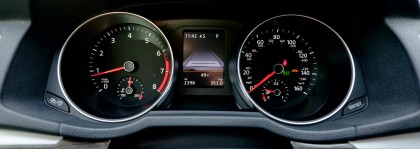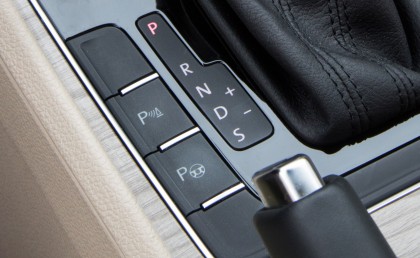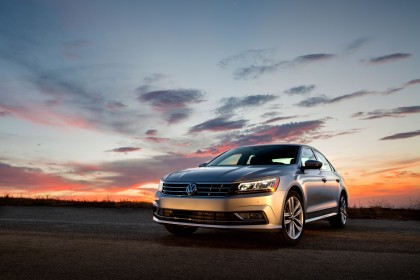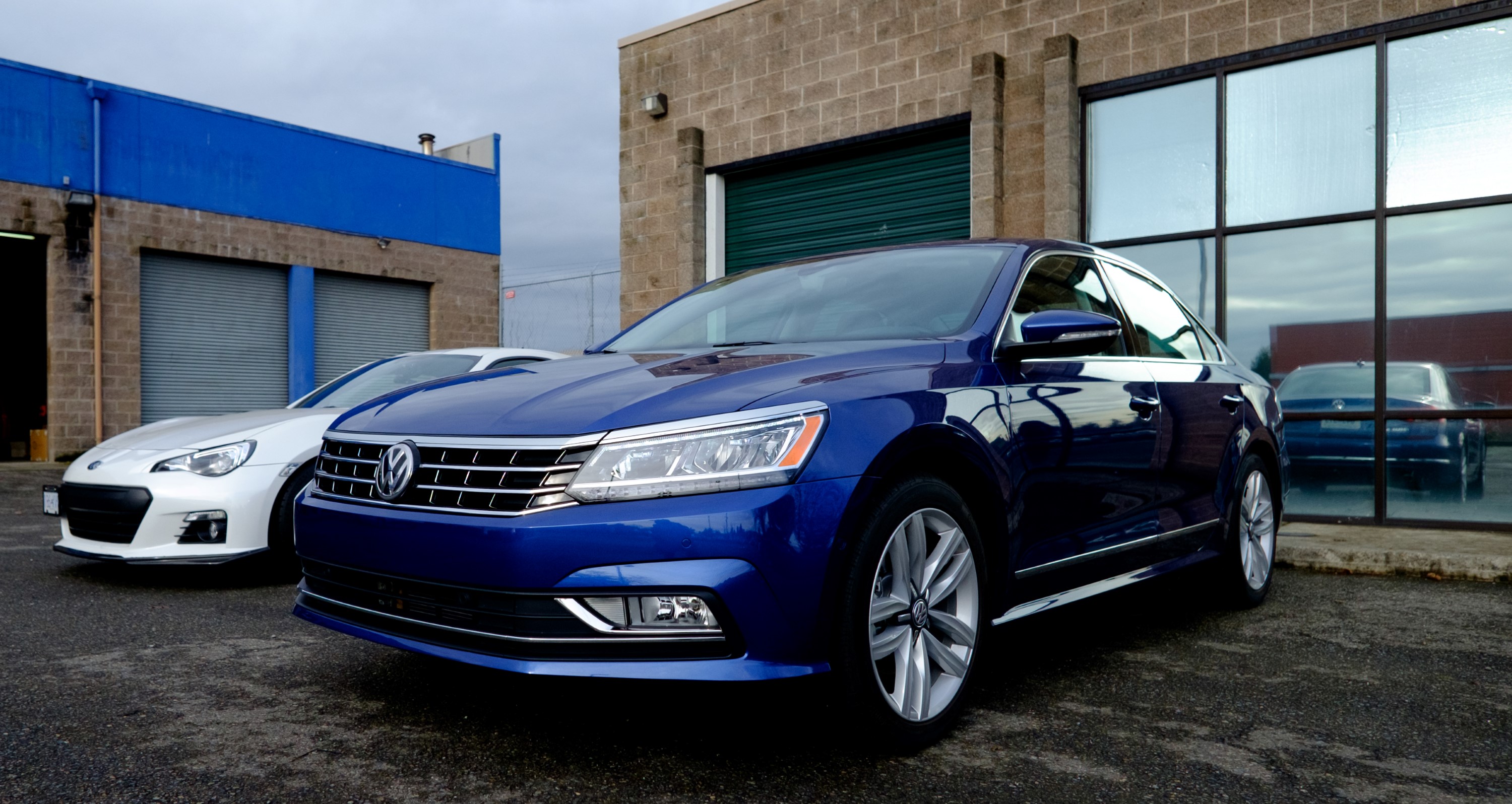Why you can trust TechRadar

Prior to the refresh, VW did not offer any driver assist technologies on the Passat. The fresh 2016 Passat steps things up with available adaptive cruise control (ACC), lane-keep assist, a blind spot monitor (BSM), autonomous emergency braking (AEB), a hands-free easy open trunk and park assist.
I'm a big fan of ACC in cars, but the Passat's implementation is disappointing because it isn't a full-speed range system with stop and go. Unlike the Kia Optima, Hyundai Sonata or Subaru Legacy, the Passat's ACC cannot stop or hold the car for you when traffic comes to a stop.
It works like all other ACC systems wherein you turn on cruise control, set a speed and select one of the four following distances. Where it differs is what happens when traffic starts to slow down. When traffic drops somewhere below 19 mph, the LCD display in the gauge cluster tells you to apply the brakes and the cruise control disengages.
You can adjust the acceleration speed in the LCD gauge cluster display, too. VW has three settings labeled Normal, Sport and Eco – one of which should theoretically match your driving style. I set it to Sport during my testing, and found it to accelerate not overly aggressive, similar to when you push the gas pedal all the way down and spin the tires, but it's not painfully slow, either.
If you're going on a road trip or cruising along an empty highway, the Passat's ACC wouldn't be too bad. For those of us that are stuck in stop-and-go traffic for daily commutes, it doesn't help relieve the stress of awful traffic at all.
Lane-keep assist
Despite the mediocre adaptive cruise control implementation, VW's lane-keep assist technology actually helps keep the car within the lane markers. It's an active system that can nudge the car back into the lane if it detects the car approaching the lane markers.
The system only activates at speeds above 40 mph and isn't a semi-autonomous steering assist system, as used in higher-end Audi's. However, the lane-keep assist system in the Passat is good enough to keep inattentive drivers from veering into cars in other lanes.
I tested lane-keep assist on the highway without too much traffic and can report it works. It's a bit unnerving to let the car approach the lane without correcting it, but once the Passat approached the lane marker, the car gave audible, visual warnings and applied corrective steering action to prevent the car from leaving the lane.
You can fight the corrective actions, though. The amount of torque applied is minimal, so you can theoretically fight the system and change lanes without signaling. Lane-keep assist is inactive if the turn signals are on.
Lane-keep assist systems gives the Passat a slight lead on its competition, since most midsize sedans rely on warning systems that only notify you when you're leaving the lane without signaling.
The best of the rest
VW's blind spot monitor places a notification indicator in each of the side mirrors. I didn't get a chance to thoroughly test this feature, as there was a limited amount of time. From the few times I got audible and visual alerts while driving, the system was very conservative. It alerted me when there was about a car length between my car and the car in the next lane.
Autonomous emergency braking (AEB) is not a feature I can safely test yet. When I can devise a way to do so, other than asking a friend to run in front of a car, I will definitely force it to work. However, the system in the Passat seems to only detect vehicles that are in front of you – it does not seem to be a pedestrian-detection system.
VW's system simply warns and then applies the brakes if the car in front of you stops quicker than your reaction time to reduce the likelihood of impact. You can adjust the sensitivity of the AEB system in the LCD gauge cluster display.
The hands-free, easy-open trunk on the Passat doesn't always work. When the car is locked, you can walk up to the back of it and wave your foot beneath the rear bumper to trigger the trunk release. This doesn't always work and sometimes it leaves you looking silly trying to perform karate moves to get the trunk to open.
When the sensor catches on and releases the trunk, the easy-open trunk lid quickly flies open without the need of a motor. VW employs hydraulic trunk struts for that purpose, which is something we wish other car makers would use.
The last driver assist feature the Passat offers is a park assist system that helps steer the car into parallel and perpendicular parking spots. Park assist needs to be manually triggered by pressing the button located next to the shifter when you want it to scan for parking spots. One press of the button tells the system to search for parallel spots the car can fit in and two presses searches for perpendicular spots.

The system is easy to use, and once it detects a suitable spot, you just put the car into reverse, let go of the steering wheel and control gas and brake functions while the car steers itself into the spot. Occasionally the car will ask you to shift into drive to correct itself, but the entire steering process is automated.
I always find park assist systems very cool, and the Passat is no different. The car is parking itself using a series of sensors, but it can only scan for parking spots at speeds of under 25 mph per hour. This shouldn't be an issue if the drivers behind you are polite and patient, but if you're driving through a busy city and need to pull into a parallel parking spot front-end first to claim it and then park accordingly, it isn't too useful.
Early verdict
Volkswagen's new Passat brings a lot of welcomed changes and additions to a car that originally debuted for the 2012 model year. The new MIB II infotainment system is an improvement that brings universal smartphone connectivity for iOS and Android users.
Apple CarPlay, Android Auto and the native functions are backed with a fluid user interface and a responsive touchscreen. Unfortunately, the 6.5-inch screen size is small compared to competitors that offer 7- and 8-inch screens.

I appreciate that VW added all the driver assist technology, but adaptive cruise control is disappointing, since it can't stop the car completely. The odd thing is the AEB system can apply brakes to stop the car and lessen the impact force, but it can't combine the full braking capabilities with the adaptive cruise control. In a tough segment where hungrier competitors are offering full-speed stop and go ACC systems, the Passat feels ancient.
Lane-keep assist on the Passat works well and can save split-second inattentiveness from veering into another car. It's not a substitute for attentive driving habits, but provides an extra layer of safety.
While the park assist feature is cool and works, in theory, I've yet to encounter many situations where I need the car to park itself. I personally prefer 360-degree cameras that let me see the entire car so I can park it myself.
Nevertheless, the VW Passat is better than ever when it comes to in-car technology. But when it comes to driving tech, this German sedan falls behind the tough American, Japanese and Korean competition.
- 1
- 2
Current page: Driver assists and our early verdict
Prev Page Infotainment, Android Auto and CarPlayWhat is a hands on review?
Hands on reviews' are a journalist's first impressions of a piece of kit based on spending some time with it. It may be just a few moments, or a few hours. The important thing is we have been able to play with it ourselves and can give you some sense of what it's like to use, even if it's only an embryonic view. For more information, see TechRadar's Reviews Guarantee.
